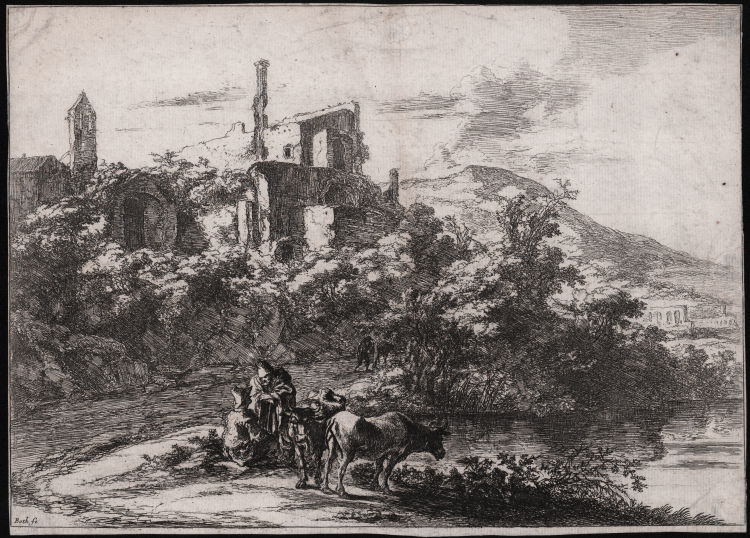




| Reference: | S42046 |
| Author | Jan BOTH |
| Year: | 1645 |
| Measures: | 275 x 195 mm |



| Reference: | S42046 |
| Author | Jan BOTH |
| Year: | 1645 |
| Measures: | 275 x 195 mm |
Etching, 1645 – 1650 circa, signed in the image, lower left “Both fe”.
From a series of six plates Landscapes of the Environs of Rome.
The plate shows two shepherds with cows in conversation in a landscape with two cows standing on the banks of the river at right, buildings in left middle distance, and ruins of Hadrian's Villa in right background.
Jan Both (Utrecht 1610 – Utrecht 1652) was the main pioneer of Italianate landscape in 17th-century Holland. He introduced to Dutch landscape a style based on the work of Claude Lorraine in Rome. His Italianate landscape style was developed by such painters as Nicolaes Berchem in Haarlem. It also influenced the development of Cuyp. He rarely dated his works, and they can be difficult to place exactly. Like the Italianate landscapes of Cuyp, Both's works were prized by Dutch patricians, who preferred them to the native Dutch landscapes in the manner of Van Goyen.
A fine impression, printed on contemporary laid paper, trimmed to the platemark, very good condition.
Bibliografia
Hollstein, 8; Bartsch, V.208.8.
Jan BOTH (Utrecht 1610 - 1652)
|
Jan Both (Utrecht 1610 – Utrecht 1652) was the main pioneer of Italianate landscape in 17th-century Holland. He introduced to Dutch landscape a style based on the work of Claude in Rome. His Italianate landscape style was developed by such painters as Nicolaes Berchem in Haarlem. It also influenced the development of Cuyp.
Jan Both was born in Utrecht, the son of a glass painter and engraver, and probably trained there under Abraham Bloemaert. He was in Rome by 1638, living with his elder brother, Andries. He returned to Utrecht about 1641, where he remained. Jan Both imitates the light of the Roman Campagna as depicted by Claude, rather than his pictorial construction. His landscapes sometimes include views of Rome and Tivoli. He occasionally produced religious or mythological scenes with figures by other painters, such as the Gallery's 'A Landscape with the Judgement of Paris'.
He rarely dated his works, and they can be difficult to place exactly. Like the Italianate landscapes of Cuyp, Both's works were prized by Dutch patricians, who preferred them to the native Dutch landscapes in the manner of Van Goyen.
He was one of the foremost painters among the second generation of DUTCH ITALIANATES. While working in Italy he specialized in genre scenes; however, on his return to the Netherlands he concentrated on wooded landscapes bathed in a golden light that illuminates the highly detailed foliage and trees. These realistic landscapes represent his most original contribution to Dutch painting and were much imitated by his contemporaries and by later artists.
|
Jan BOTH (Utrecht 1610 - 1652)
|
Jan Both (Utrecht 1610 – Utrecht 1652) was the main pioneer of Italianate landscape in 17th-century Holland. He introduced to Dutch landscape a style based on the work of Claude in Rome. His Italianate landscape style was developed by such painters as Nicolaes Berchem in Haarlem. It also influenced the development of Cuyp.
Jan Both was born in Utrecht, the son of a glass painter and engraver, and probably trained there under Abraham Bloemaert. He was in Rome by 1638, living with his elder brother, Andries. He returned to Utrecht about 1641, where he remained. Jan Both imitates the light of the Roman Campagna as depicted by Claude, rather than his pictorial construction. His landscapes sometimes include views of Rome and Tivoli. He occasionally produced religious or mythological scenes with figures by other painters, such as the Gallery's 'A Landscape with the Judgement of Paris'.
He rarely dated his works, and they can be difficult to place exactly. Like the Italianate landscapes of Cuyp, Both's works were prized by Dutch patricians, who preferred them to the native Dutch landscapes in the manner of Van Goyen.
He was one of the foremost painters among the second generation of DUTCH ITALIANATES. While working in Italy he specialized in genre scenes; however, on his return to the Netherlands he concentrated on wooded landscapes bathed in a golden light that illuminates the highly detailed foliage and trees. These realistic landscapes represent his most original contribution to Dutch painting and were much imitated by his contemporaries and by later artists.
|